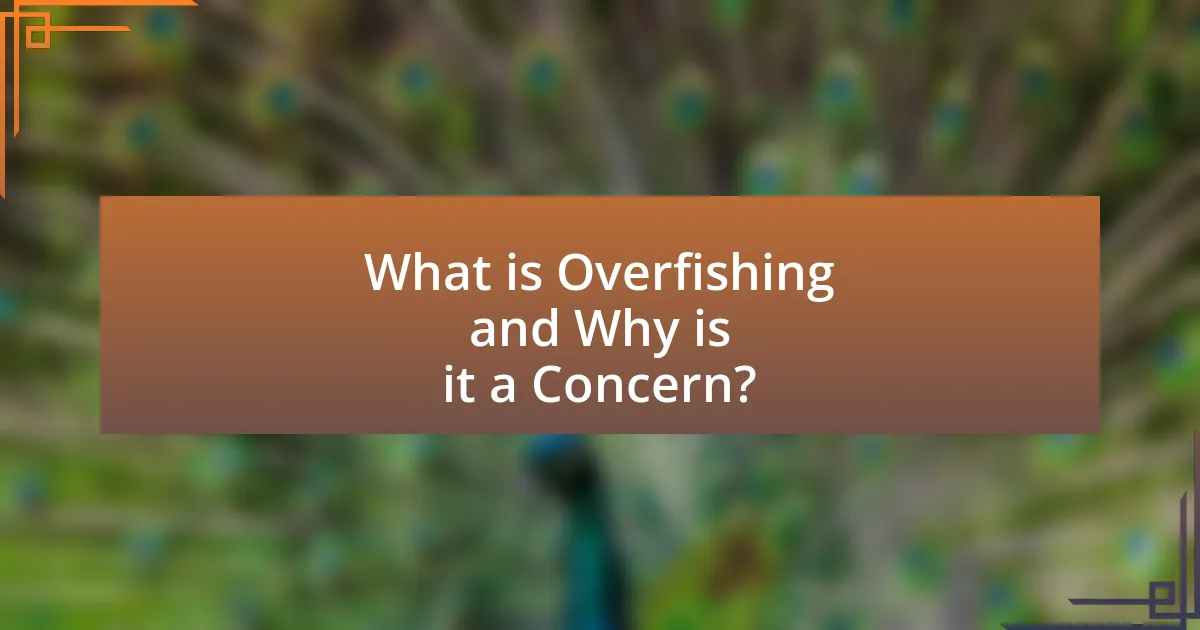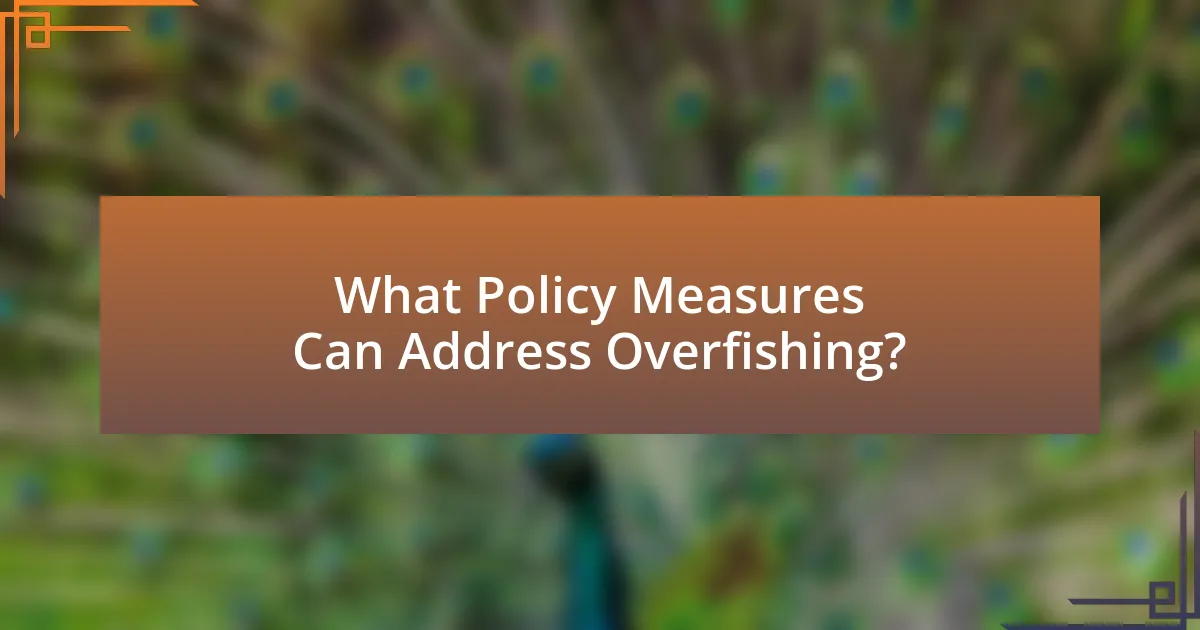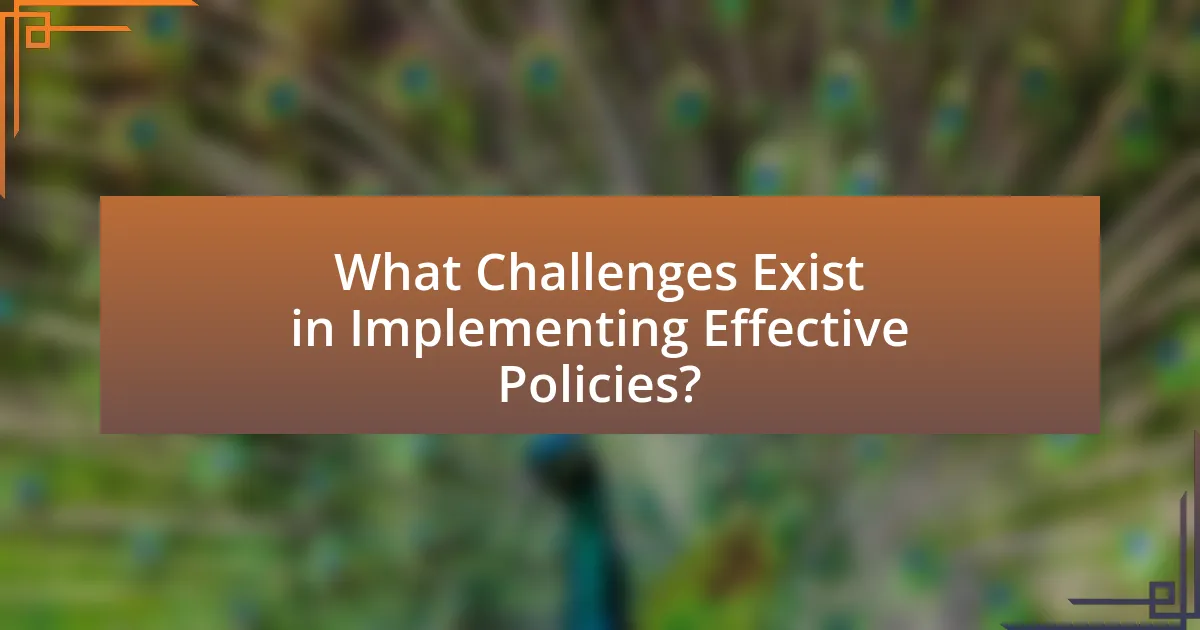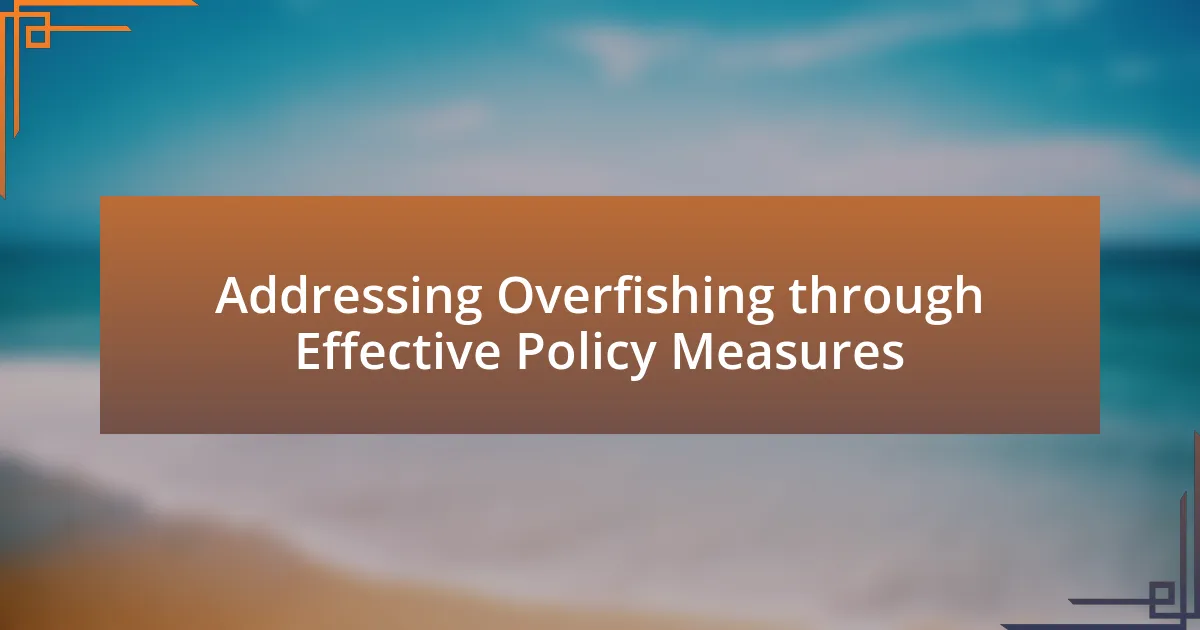Overfishing is the practice of catching fish at a rate that surpasses their natural reproductive capacity, leading to significant declines in fish populations and threatening marine ecosystems. This article examines the implications of overfishing, including its impact on biodiversity, food security, and the economic stability of fishing communities. It discusses the effectiveness of policy measures such as catch limits and marine protected areas in managing fish stocks and highlights the challenges in implementing these policies, including illegal fishing and corruption. Additionally, it explores best practices and technological advancements that can enhance sustainable fishing efforts and improve stakeholder engagement in conservation initiatives.

What is Overfishing and Why is it a Concern?
Overfishing is the practice of catching fish at a rate that exceeds their natural ability to reproduce, leading to a decline in fish populations. This is a concern because it disrupts marine ecosystems, threatens biodiversity, and jeopardizes the livelihoods of communities that depend on fishing. According to the Food and Agriculture Organization (FAO), approximately 34% of global fish stocks are overfished, which can result in the collapse of fish populations and the loss of species. The depletion of fish stocks also affects food security, as fish is a primary source of protein for billions of people worldwide.
How does overfishing impact marine ecosystems?
Overfishing significantly disrupts marine ecosystems by depleting fish populations and altering food webs. When key species are overexploited, it leads to imbalances that can cause the decline of predator and prey relationships, ultimately affecting biodiversity. For instance, the collapse of cod stocks in the North Atlantic has resulted in increased populations of smaller fish and invertebrates, which further alters the ecosystem dynamics. Additionally, overfishing can lead to habitat destruction, as practices like bottom trawling damage seabeds, impacting various marine organisms that rely on these habitats for survival. Studies indicate that overfishing has contributed to a 90% decline in large predatory fish populations since the mid-20th century, underscoring its profound impact on marine life and ecosystem health.
What species are most affected by overfishing?
The species most affected by overfishing include Atlantic cod, bluefin tuna, and various shark species. Atlantic cod populations have declined by over 90% since the 1960s due to excessive fishing pressure. Bluefin tuna, highly sought after for sushi, have seen their populations drop by approximately 80% from historical levels. Additionally, many shark species, such as the hammerhead and thresher sharks, are severely impacted, with some populations declining by over 70% due to targeted fishing and bycatch. These statistics highlight the critical state of these species as a direct consequence of overfishing practices.
How does overfishing disrupt food chains?
Overfishing disrupts food chains by depleting key fish populations, which are essential for maintaining ecological balance. When specific species are overfished, their predators may face food shortages, leading to declines in their populations as well. For example, the overfishing of sardines can negatively impact larger fish species like tuna and seabirds that rely on sardines as a primary food source. Additionally, the removal of certain fish can lead to an increase in their prey species, causing imbalances that affect the entire marine ecosystem. Studies have shown that overfishing can lead to a 50% reduction in fish populations, which directly correlates with the destabilization of marine food webs.
What are the economic implications of overfishing?
Overfishing leads to significant economic implications, primarily through the depletion of fish stocks, which adversely affects the fishing industry and related economies. The decline in fish populations results in reduced catches, leading to lower incomes for fishermen and increased prices for consumers. According to the Food and Agriculture Organization, overfishing has caused global fish stocks to decline by approximately 30% since the 1970s, which directly impacts livelihoods in coastal communities that rely on fishing as a primary source of income. Additionally, the loss of biodiversity due to overfishing can disrupt marine ecosystems, further jeopardizing future fishing yields and economic stability. The economic burden extends to increased costs for fishery management and restoration efforts, which can strain public resources and affect other sectors reliant on healthy marine environments.
How does overfishing affect fishing communities?
Overfishing significantly undermines fishing communities by depleting fish stocks, which are essential for their livelihoods. As fish populations decline, fishermen face reduced catches, leading to lower incomes and economic instability within these communities. For instance, a study by the Food and Agriculture Organization (FAO) reported that overfishing has led to a 50% decline in global fish stocks since the 1970s, directly impacting the economic viability of fishing-dependent regions. Consequently, communities may experience increased unemployment, food insecurity, and social challenges as traditional fishing practices become unsustainable.
What are the long-term costs of overfishing on fisheries?
The long-term costs of overfishing on fisheries include significant declines in fish populations, ecosystem degradation, and economic losses for fishing communities. Overfishing leads to the depletion of key species, which disrupts marine ecosystems and reduces biodiversity. For instance, the Food and Agriculture Organization reported that approximately 34% of global fish stocks are overfished, resulting in lower catches and diminished future yields. Additionally, the economic impact is profound; the World Bank estimated that the global cost of overfishing could reach $83 billion annually due to lost revenue and increased management costs. These factors collectively threaten the sustainability of fisheries and the livelihoods dependent on them.

What Policy Measures Can Address Overfishing?
Policy measures that can address overfishing include implementing catch limits, establishing marine protected areas, and enforcing sustainable fishing practices. Catch limits, based on scientific assessments, help prevent fish populations from declining to unsustainable levels; for instance, the U.S. National Oceanic and Atmospheric Administration (NOAA) sets annual catch limits to ensure fish stocks remain healthy. Marine protected areas restrict fishing in designated zones, allowing ecosystems to recover; studies show that such areas can lead to increased fish biomass and biodiversity. Additionally, enforcing sustainable fishing practices, such as using selective gear and reducing bycatch, can minimize the impact on non-target species and habitats, as demonstrated by successful fisheries management in countries like Norway.
How do catch limits help in managing fish populations?
Catch limits help in managing fish populations by regulating the amount of fish that can be harvested, thereby preventing overfishing. These limits are established based on scientific assessments of fish stocks, which take into account factors such as reproduction rates and population health. For instance, the National Oceanic and Atmospheric Administration (NOAA) sets catch limits to ensure that fish populations remain sustainable, which has been shown to lead to recovery in overfished species. In 2018, the U.S. saw a 20% increase in the biomass of key fish stocks due to effective catch limit policies. This demonstrates that catch limits are a crucial tool in maintaining ecological balance and ensuring the long-term viability of fish populations.
What factors determine the setting of catch limits?
The factors that determine the setting of catch limits include the biological status of fish stocks, ecological considerations, socio-economic impacts, and regulatory frameworks. The biological status of fish stocks is assessed through scientific evaluations of population sizes, reproductive rates, and sustainability thresholds, which inform how many fish can be caught without jeopardizing future populations. Ecological considerations involve the health of marine ecosystems and the interdependence of species, ensuring that catch limits do not disrupt the balance of marine life. Socio-economic impacts take into account the livelihoods of fishing communities and market demands, aiming to balance conservation efforts with economic viability. Regulatory frameworks, often established by governmental and international bodies, provide the legal basis for setting and enforcing these limits, ensuring compliance and sustainability.
How effective are catch limits in different regions?
Catch limits are effective in various regions, with their success largely dependent on local enforcement, species targeted, and ecological conditions. For instance, in the North Atlantic, catch limits have contributed to the recovery of cod stocks, with the International Council for the Exploration of the Sea reporting a significant increase in biomass since the implementation of stricter limits. Conversely, in regions like the Mediterranean, catch limits have been less effective due to inadequate enforcement and high levels of illegal fishing, leading to continued overfishing of species such as bluefin tuna. Studies indicate that regions with robust monitoring and compliance mechanisms, such as New Zealand, show higher effectiveness of catch limits, resulting in sustainable fish populations and healthier marine ecosystems.
What role do marine protected areas play in combating overfishing?
Marine protected areas (MPAs) play a crucial role in combating overfishing by providing designated regions where fishing activities are restricted or regulated to allow fish populations to recover. These areas help to restore biodiversity and enhance fish stocks, which can spill over into adjacent fishing zones, thereby benefiting local fisheries. Research indicates that MPAs can lead to a significant increase in fish biomass; for instance, a study published in the journal “Nature” found that fish populations in fully protected areas can be up to 600% larger than in unprotected areas. This evidence demonstrates that MPAs are effective tools in sustainable fisheries management and contribute to the long-term health of marine ecosystems.
How are marine protected areas established and enforced?
Marine protected areas (MPAs) are established through a process that involves stakeholder engagement, scientific assessment, and regulatory frameworks. Governments or relevant authorities identify critical marine ecosystems and habitats that require protection, often using scientific data to assess biodiversity and ecological significance.
Once identified, the establishment process typically includes public consultations to gather input from local communities, fishermen, conservationists, and other stakeholders. This collaborative approach ensures that the interests and needs of various parties are considered. Following consultations, legal frameworks are enacted to designate the area as an MPA, which may involve national legislation or international agreements.
Enforcement of MPAs is carried out through monitoring and compliance mechanisms, which can include patrols by enforcement agencies, use of technology such as satellite tracking, and community-led initiatives. Effective enforcement is crucial to prevent illegal activities such as overfishing and habitat destruction. Studies have shown that well-enforced MPAs can lead to significant increases in fish populations and biodiversity, demonstrating their effectiveness in addressing overfishing and promoting sustainable marine ecosystems.
What are the success stories of marine protected areas?
Marine protected areas (MPAs) have successfully contributed to the recovery of fish populations and marine biodiversity. For instance, the Great Barrier Reef Marine Park in Australia has seen a significant increase in coral cover and fish biomass since its establishment in 1975, with fish populations doubling in some areas due to reduced fishing pressure. Similarly, the Cabo Pulmo National Park in Mexico, which was designated as a no-take zone in 1995, experienced a remarkable recovery, with fish biomass increasing by over 400% within a decade. These examples demonstrate that well-managed MPAs can effectively restore marine ecosystems and support sustainable fisheries.

What Challenges Exist in Implementing Effective Policies?
Implementing effective policies to address overfishing faces several challenges, including political resistance, lack of stakeholder engagement, and insufficient data. Political resistance often arises from conflicting interests among stakeholders, such as fishing industries and environmental groups, which can hinder consensus on policy measures. Additionally, lack of stakeholder engagement, particularly from local fishing communities, can lead to policies that are not well-informed or accepted, reducing their effectiveness. Insufficient data on fish populations and ecosystem health complicates the development of evidence-based policies, making it difficult to assess the impact of overfishing accurately. These challenges collectively impede the creation and enforcement of effective policies aimed at sustainable fishing practices.
What are the barriers to enforcing fishing regulations?
Barriers to enforcing fishing regulations include insufficient funding, lack of political will, and inadequate monitoring and enforcement mechanisms. Insufficient funding limits the resources available for patrols and surveillance, making it difficult to catch illegal fishing activities. Lack of political will often results in weak enforcement of existing laws, as governments may prioritize economic gains from fishing over sustainability. Additionally, inadequate monitoring systems, such as the absence of technology for tracking fishing vessels, hinder the ability to enforce regulations effectively. These factors collectively contribute to the challenges faced in maintaining sustainable fishing practices.
How does illegal fishing undermine policy efforts?
Illegal fishing undermines policy efforts by circumventing regulations designed to protect fish populations and marine ecosystems. This practice leads to overexploitation of fish stocks, making it difficult for governments to achieve sustainable management goals. For instance, the Food and Agriculture Organization (FAO) estimates that illegal, unreported, and unregulated (IUU) fishing accounts for up to 26 million tons of fish caught annually, which significantly disrupts the balance of marine biodiversity and hinders recovery efforts for overfished species. Consequently, the presence of illegal fishing activities diminishes the effectiveness of conservation policies and enforcement measures, ultimately threatening the long-term viability of fisheries and the livelihoods dependent on them.
What role does corruption play in fishing governance?
Corruption undermines fishing governance by facilitating illegal fishing practices and enabling the misallocation of resources. It allows individuals and organizations to bypass regulations, leading to overfishing and depletion of fish stocks. For instance, a report by the World Bank indicates that illegal, unreported, and unregulated fishing costs the global economy up to $23 billion annually, largely due to corrupt practices that evade enforcement. Furthermore, corruption can distort policy-making processes, resulting in ineffective management strategies that fail to protect marine ecosystems.
How can stakeholder engagement improve policy effectiveness?
Stakeholder engagement can significantly improve policy effectiveness by ensuring that diverse perspectives and expertise are incorporated into the decision-making process. When stakeholders, such as fishermen, conservationists, and local communities, actively participate, policies are more likely to address the real needs and challenges of those affected. For instance, research by the Food and Agriculture Organization (FAO) indicates that inclusive stakeholder engagement leads to better compliance and support for policies, as stakeholders feel a sense of ownership and responsibility towards the outcomes. This collaborative approach not only enhances the relevance of policies but also fosters trust and transparency, which are crucial for successful implementation in addressing issues like overfishing.
What strategies can be used to involve local communities?
To involve local communities in addressing overfishing, strategies such as participatory management, community-based fisheries management, and educational outreach can be employed. Participatory management allows local stakeholders to have a voice in decision-making processes, fostering a sense of ownership and responsibility towards marine resources. Community-based fisheries management has been shown to enhance sustainability by empowering local fishers to manage their resources effectively, as evidenced by successful initiatives in places like the Philippines, where local governance has led to improved fish stocks. Educational outreach programs raise awareness about the impacts of overfishing and promote sustainable practices, which can lead to community engagement and behavioral change.
How can collaboration between governments and NGOs enhance policy outcomes?
Collaboration between governments and NGOs can enhance policy outcomes by integrating diverse expertise and resources, leading to more effective and sustainable solutions. Governments provide regulatory frameworks and authority, while NGOs contribute specialized knowledge, community engagement, and advocacy skills. For instance, the partnership between the World Wildlife Fund (WWF) and various governments has led to the successful implementation of marine protected areas, which are crucial for addressing overfishing. Research indicates that such collaborations can improve compliance rates and foster community support, ultimately resulting in better conservation outcomes.
What Best Practices Can Be Adopted to Combat Overfishing?
To combat overfishing, best practices include implementing sustainable fishing quotas, enforcing marine protected areas, and promoting responsible fishing techniques. Sustainable fishing quotas, based on scientific assessments, help maintain fish populations at healthy levels; for instance, the International Council for the Exploration of the Sea recommends catch limits to prevent stock depletion. Marine protected areas restrict fishing in critical habitats, allowing ecosystems to recover; studies show that such areas can lead to increased fish biomass and biodiversity. Additionally, promoting responsible fishing techniques, such as selective gear and bycatch reduction methods, minimizes environmental impact and preserves non-target species. These practices collectively contribute to the long-term sustainability of marine resources.
How can technology be leveraged to monitor fish stocks?
Technology can be leveraged to monitor fish stocks through the use of satellite imagery, acoustic sensors, and data analytics. Satellite imagery allows for the tracking of fishing vessels and the assessment of ocean conditions, while acoustic sensors can detect fish populations and their movements underwater. Data analytics processes large datasets from these technologies to provide insights into fish stock levels and trends. For instance, a study published in the journal “Nature” demonstrated that satellite data could improve the accuracy of fish stock assessments by up to 30%, highlighting the effectiveness of these technological tools in sustainable fisheries management.
What educational initiatives can raise awareness about sustainable fishing?
Educational initiatives that can raise awareness about sustainable fishing include community workshops, school programs, and online campaigns. Community workshops engage local fishermen and residents, providing hands-on training about sustainable practices and the ecological impacts of overfishing. School programs introduce students to marine biology and conservation, fostering a sense of responsibility towards aquatic ecosystems. Online campaigns utilize social media platforms to disseminate information and share success stories, reaching a broader audience. Research indicates that educational outreach significantly increases public knowledge and engagement in sustainable fishing practices, as evidenced by a study published in the journal “Marine Policy,” which found that communities involved in educational initiatives showed a 30% increase in sustainable fishing practices over three years.
